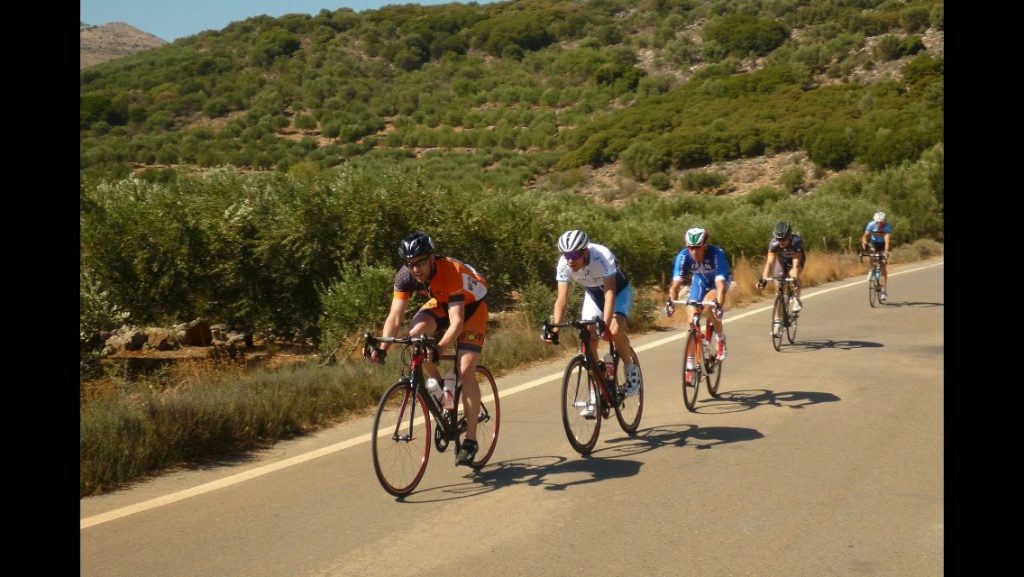Case Study
When Coaching Really Counts
Whenever I speak to athletes about how they can improve, hard work is never the issue. Most endurance athletes are more than willing to put in the hard work. What is more of an issue is when someone is working too hard, so much of the effort goes to waste, and there are so many downsides to the type of training….this is where a coach can really help!
Background
Athlete – 40 – something-year-old female cyclist with no history of bike racing. Started cycling to stay fit and enjoy group rides with friends.
Had completed some substantial sportive events in the past few years, including some excellent rides around the 6-hour mark.
More recently, due to changes in work, training had been more about spin sessions in the week and outdoor riding at the weekend.
Where did we Start?
Starting in March 2022, an analysis of recent training showed that it was almost all high-intensity training. 2-3 very hard spin sessions in the week and a hard group ride at the weekend. You can see the intensity distribution below:
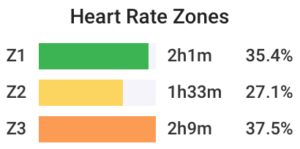
As you can see, there is far too much high-intensity work going on and nowhere near enough low-intensity work to support it.
There are many disadvantages to this; metabolically, you are inefficient as an endurance athlete, high dependence on carbohydrates as fuel, constant stimulation of the sympathetic nervous system, and I’m afraid burnout is not far in your future.
As you can also see in the picture above, the overall volume is relatively low, lower than the athlete actually wanted; this is mainly because, at these intensities, volume is almost impossible. Even on this low volume, this represents over-training.
Testing
Once we got up and running, we did a sub-max ramp test, results on the graph below:
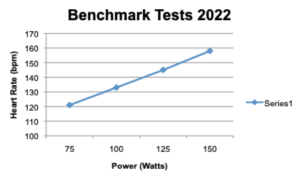
You can’t necessarily learn that much from one test, and repeated tests help you learn a lot more. But what you can see is that the HR is fairly high right from the start and that the linear nature of the graph tells you there is potentially low aerobic power and a reliance on anaerobic energy contribution.
As with all new riders, one of the most important things is beginning to understand each other as athlete and coach. We’re a team, so a lot of the early coaching calls reflected the learning process we both had to go through.
Particularly important is that the athlete knows what they are doing and why they are doing it. This really helps, especially when you are trying to convince someone they will get fitter by going slower…this doesn’t make intuitive sense, so needs to be backed up with a deeper understanding.
Phase 1 – The Training Week
The main emphasis initially was to learn to ride slower, which takes a bit of doing. Living in a hilly area means that there is a need to seek out flatter routes initially, which we did.
The weeks initially consisted of 2 x Z1 turbo sessions and one long ride at the weekend, where all zones would need to be used. I still encouraged her to use Z1 as much as possible, but all 3 would be needed.

Phase 2 – Progression
It wasn’t long before things started moving in the right direction. In fact, progression was quicker than I had anticipated, which is always nice.
With the intensity a little more under control, we were able to push the volume up a bit without overloading too much. We moved to 4 rides a week, adding an easy hour on the turbo on Sunday mornings.

Typically, at this time, we were up to doing about 7-9 hours on the bike each week. Crucially, the intensity control meant that at the end of the week, the rider wasn’t completely smashed; it was sustainable…and that’s where you find the big gains!!
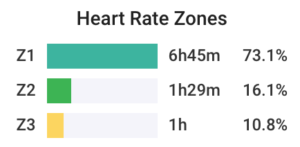
This is the intensity distribution from the diary week above…big contrast to where we started in March!!
A typical sweet spot session on the turbo looked like this, with 6×5 mins controlled over-geared efforts:
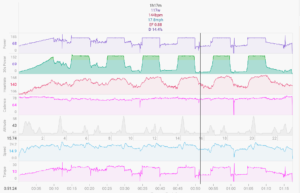
These gradually progressed to longer efforts, and obviously, the watts were adjusted as we progressed.
It Doesn’t Always Go To Plan!
No matter how well you train or plan…things can go wrong! Unfortunately, we had a bit of an interruption in training due to illness. The time was really frustrating for both of us as the training had gone so well and form was great going into the first two goals we had aimed for together…But that’s the way it goes sometimes!
All you can do is make the next right step.
Phase 3 – New Goals
We set out sights on 3 new goals:
- The Club 100 mile ride
- Compete in first ever 10 mile Time Trial
- Week Long Trip to Majorca
Building slowly back to where we were pre-illness was the first thing. Then we pushed on to the next level. Outdoor riding was now much more under control intensity-wise, so we were able to add in more Sweet Spot and Threshold work in the week, which was brilliant.
By June, we were consistently doing 8-11 hours per week, and with occasional easy weeks, there was no sign of any burnout. Even with a massive 16-hour overload week while off work, we weren’t risking overtraining.
With the first 2 goals approaching, we re-tested with the sub-max test, and the results were very encouraging, to say the least!

As you can see…there’s a massive drop in heart rate at every level!! This indicates a far more efficient metabolism and much more fat burning.
The Time Trial
We knew going into the TT tired (it was the week after the 16-hour epic), but her first 10TT was going to be great…first one is always a PB 🙂
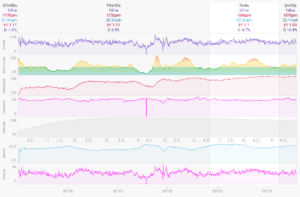
A fantastic effort…28:10 for 10 miles on a road bike with no aero kit at all is an incredible result.
Then just 10-days later, we went for the 100 miler! With great legs, it was completed with no issues…and I’ll maybe leave it to the rider themselves to describe it (See Below).
What the Athlete Has to Say
A structured periodised plan built around my goals means I have continuity and focus, but with flexibility and adaptations when needed.
I have a much greater understanding of my fitness levels and how to train smarter. I’m certainly reaping the rewards of trust and patience with significant gains in my performance.
Much more than a training plan… it’s fun too.’

The 100 Miler
Riding 100miles is not new to me but riding 100miles, however, not suffering from fatigue at the end of the ride and for days after is.
This time I was in a great physical place and with a better understanding of endurance efforts and metabolic control.
My training plan has consisted of many lower-effort Z1 rides mixed in with shorter, higher-intensity efforts. So riding slower to ride faster… There is a reason behind this, and as counterintuitive and weird as it sounds, it works!!
Six plus hours of undulating Welsh roads; while this was a more challenging route than previous 100s, it was by far one of the easiest 100 miles I have ridden.
To Summarise
In 6 months of coaching, we’ve made some reasonably big changes to the training strategy, which have led to even bigger changes to the performance!
In preparing for this post, I looked back at LT1 and LT2 changes, and it took me a bit by surprise. I knew we had made decent progress, but as you can see on the right, what used to be LT2 Watts is now LT1…this makes such a massive difference to every aspect of riding.
An extra 35 Watts at LT1 and an extra 27 Watts at LT 2 is a massive improvement!!
The trip to Majorca is next month, so we have a bit more work to do before some good rest and setting goals for next year.
Most exciting is there is a lot more to come!

Talk to a Coach
If you would like to see what coaching could do for you, book your free coaching call by emailing:
What can we do for You?
With a coach, you are part of a team. Together we make a plan tailored to your goals and your lifestyle

